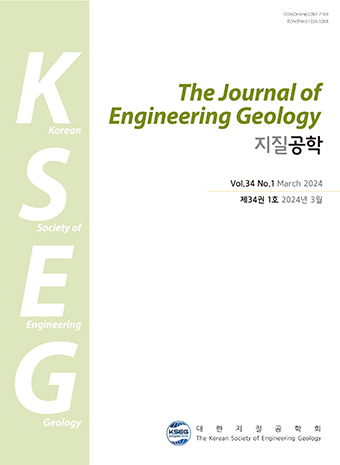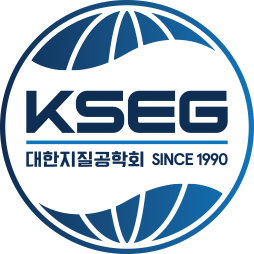Instructions for Authors
(Enacted in March 1991, most recently revised in March 2018)
The Journal of Engineering Geology (JEG) is the official journal of The Korean Society of Engineering Geology. The journal contains original articles, reviews, technical reports, discussions, field reports, and special features on topics in engineering geology and associated academic fields. It is published quarterly in March, June, September, and December. Supplements are published from time to time. Manuscripts written in Korean or English are accepted. Authors are advised to prepare and submit manuscripts in accordance with these instructions.
Manuscript Preparation
The title page should contain the title of the manuscript and the name(s) and organization(s) of the author(s).
▬ Front page
The front page of manuscripts should contain the title, name(s) and organization(s) of the author(s), abstract, and keywords. These are followed by the main text, acknowledgement, appendices, and references. The corresponding author should be identified with an asterisk and a footnote. The email address, phone number, and fax number of the corresponding author should be included in the endnote.
▬ Abstract and Keywords
An abstract of no more than 300 words should be provided with the manuscript. The abstract must be intelligible without reference to the full paper, and should be a condensation of the essential information in the paper and not a recital of the subjects covered. Authors are requested to supply up to six keywords for indexing/abstracting purposes.
▬ Main text
The main text should be written in double-spaced format with 3.0 cm margins. SI units should be used wherever possible. All publications cited in the main text, tables, and figures should be presented in a list of references (references section) following the main text of the manuscript. References cited in the main text and captions should be referred to in the form of authors’ surnames and year of publication (e.g., Batzle et al., 1980; Ahrens and Rubin, 1983) and arranged first by chronological order and then by alphabetical order. Lower-case letters should be used to distinguish references that would otherwise have identical citations (e.g., Park (2012a), Park (2012a, 2012b), or (Park, 2012a, 2012b)).
▬ Figures and Tables
All figures and tables should be clearly marked using Arabic numerals in order of their reference in the main text. Each figure and table must be provided with a self-explanatory caption. Illustrations such as photographs, charts, and diagrams are all referred to as figures. Illustrations should be prepared in sufficient quality to withstand the inevitable loss of contrast and detail during the printing process. Color illustrations can be accepted; however, authors will be expected to make a contribution towards the extra printing costs.
▬ References
Each reference should provide bibliographic information in the order of author(s), year, title of reference, full name of journal/book, volume, and pages. The list of references should be arranged alphabetically by authors’ surnames. Examples of the journal’s format for references are as follows:
- • Seo, Y.S., Jang, H.S., Kim, K.Y., 2012, Assesment of rockfall hazard in the northeast region of Ulleungdo, The Journal of Engineering Geology, 22(3), 353-363 (in Korean with English abstract).
- • Pfeiffer, T.J., Bowen, T.D., 1989, Computer simulation of rockfalls, Bulletin Association Engineering Geology, 26(1), 135-146.
- • Max, M.D., Johnson, A.H., Dillon, W.P., 2006, Economic geology of natural gas hydrate, Springer, 341p.
- • Sabatini, D.A., Knox, R.C., 1995, Emerging technologies in surfactant-enhanced subsurface remediation, In: Sabatini, D.A., Knox, R.C., Harwell, J.H. (Eds.), Surfactant-Enhanced Subsurface Remediation, Emerging Technologies, ACS Symposium Series 594, American Chemical Society, Washington DC, 1-9.
- • Lee, C.G., 2014, Correlation analysis of rock properties and hazard distribution using 3D FEM strike-slip fault model, MSc Thesis, Chungbuk National University, 15-19 (in Korean with English abstract).
- • World Resources Institute, 2014, The aqueduct water risk atlas, Retrieved from http://www.wri.org/our-work/project/aqueduct/aqueduct-atlas.
Submission of a paper implies that it has not been published previously, that it is not under consideration for publication elsewhere, and that if accepted it will not be published elsewhere in the same form, in English or in any other language, without the written consent of the Editorial Committee. For the polices on the research and publication ethics not stated in this instructions, International Standards for editors and authors (https://publicationethics.org/resources/resources-and-further-reading/international-standards-editors-and-authors) can be applied.
Manuscript Submission
- 1. Manuscripts should be submitted to the website (http://www.engeo.or.kr) electronically.
- 2. Manuscripts may be submitted in electronic form through the online access. Authors are asked to log in (with ‘ksengeo’ for ID and Password) to the service, to upload the manuscript to ‘Submission to the J. Eng. Geol.’ under the ‘Upload_only’ folder, and to notify Prof. Yu-Chul Park, the Editor-in-Chief (Tel: +82-33-250-8586, Email: parkyc@kangwon.ac.kr) of the submission or other correspondence.
- 3. Manuscripts must be accompanied by the Author’s Check List and Transfer of Copyright Statement. These forms are regularly published in this journal or can be obtained from http://www.engeo.or.kr.
Peer Review
All manuscripts are treated as confidential and will be reviewed by three anonymous referees selected by the Editorial Board. The final decision regarding publication will be made by the Editor-in-Chief based on the principle of majority rule. Review decisions are as follows: ‘accept as is’, ‘accept after editorial revision’, ‘resubmit after revision’, ‘accept for other types of contribution’, or ‘reject’. When the final manuscript is completely acceptable in accordance with the criteria and format of the Journal of Engineering Geology, it is scheduled for publication in the next available issue.
Ethics
For the policies on the research and publication ethics not stated in this instructions, COPE’s International Standards for Editors and Authors (International Standards for editors and authors (https://publicationethics.org/resources/resources-and-further-reading/international-standards-editors-and-authors) can be applied. Violation of publication ethics will result in the activation of COPE flow chart.
Fee for Publication
The publication fee is 100,000 Korean Won for an article up to 10 pages, and 10,000 Korean Won per additional page. Actual expenses will be charged for colored pages. An additional 100,000 Korean Won will be charged if the paper’s sponsor(s) is accredited in the Acknowledgements. Publication costs are subject to change according to the society’s financial position.


 The Journal of Engineering Geology
The Journal of Engineering Geology








